Spatial Characteristics of the Abandonment Degree of Residential Quarters Based on Data of the Housing Sales Ratio—A Case Study of Kunming, China
Abstract
1. Introduction
2. Data and Methods
2.1. Research Design
2.2. Study Area and Data Sources
2.3. Concept and Methodology
2.3.1. New Concept in Evaluating Abandonment Degree: Abandonment Rate
2.3.2. Spatial Autocorrelation Analysis
- 1.
- Global Moran’s I
- 2.
- Getis-Ord Gi*
2.3.3. Curve Estimation
3. Results and Analysis
3.1. Characteristics of Abandonment Degree in Kunming’s Main Urban District
3.2. Spatial Pattern and Spatial Association Characteristics of Abandoned Rate
3.3. Influencing Factors of Abandonment Degree
4. Discussion
5. Conclusions
Author Contributions
Funding
Data Availability Statement
Conflicts of Interest
References
- Ghazali, E.M.; Ngiam, E.Y.L.; Mutum, D.S. Elucidating the drivers of residential mobility and housing choice behaviour in a suburban township via push-pull-mooring framework. J. Hous. Built Environ. 2020, 35, 633–659. [Google Scholar] [CrossRef]
- Frey, W.H. Central city white flight: Racial and nonracial causes. Am. Sociol. Rev. 1979, 44, 425–448. [Google Scholar] [CrossRef]
- Millard-Ball, A. Gentrification in a residential mobility framework: Social change, tenure change and chains of moves in Stockholm. Hous. Stud. 2002, 17, 833–856. [Google Scholar] [CrossRef]
- Wang, L.; Wei, Y.; Omrani, H.; Pijanowski, B.; Doucette, J.; Li, K.; Wu, Y. Analysis on residential density dynamics in USA—A case study in southeast Wisconsin. Sustain. Cities Soc. 2020, 52, 101866. [Google Scholar] [CrossRef]
- Karsten, L. Housing as a way of life: Towards an understanding of middle-class families’ preference for an urban residential location. Hous. Stud. 2007, 22, 83–98. [Google Scholar] [CrossRef]
- Boterman, W.R.; Karsten, L.; Musterd, S. Gentrifiers settling down? Patterns and trends of residential location of middle-class families in Amsterdam. Hous. Stud. 2010, 25, 693–714. [Google Scholar] [CrossRef]
- Zhang, L.; Zhu, L.; Shi, D.; Hui, E.C. Urban residential space differentiation and the influence of accessibility in Hangzhou, China. Habitat Int. 2022, 124, 102556. [Google Scholar] [CrossRef]
- Cui, C.; Mu, X.; Chang, H.; Li, J.; Wang, F. Patterns and determinants of location choice in residential mobility: A case study of Shanghai. Prog. Geogr. 2021, 40, 422–432. [Google Scholar] [CrossRef]
- Wang, Y.; Wu, K.; Qin, J.; Wang, C.; Zhang, H. Examining spatial heterogeneity effects of landscape and environment on the residential location choice of the highly educated population in Guangzhou, China. Sustainability 2020, 12, 3869. [Google Scholar] [CrossRef]
- Li, S.M.; Mao, S.Q. The spatial pattern of residential mobility in Guangzhou, China. Int. J. Urban Reg. Res. 2019, 43, 963–982. [Google Scholar] [CrossRef]
- Qiang, H.L.; Hu, L.L. Population and capital flows in metropolitan Beijing, China: Empirical evidence from the past 30 years. Cities 2022, 120, 103464. [Google Scholar] [CrossRef]
- Zheng, S.; Fu, Y.; Liu, H. Housing-choice hindrances and urban spatial structure: Evidence from matched location and location-preference data in Chinese cities. J. Urban Econ. 2006, 60, 535–557. [Google Scholar] [CrossRef]
- Beckers, P.; Boschman, S. Residential choices of foreign highly skilled workers in the Netherlands and the role of neighbourhood and urban regional characteristics. Urban Stud. 2019, 56, 760–777. [Google Scholar] [CrossRef]
- Lawton, P.; Murphy, E.; Redmond, D. Residential preferences of the ‘creative class’? Cities 2013, 31, 47–56. [Google Scholar] [CrossRef]
- Acheampong, R.A. Towards incorporating location choice into integrated land use and transport planning and policy: A multi-scale analysis of residential and job location choice behaviour. Land Use Policy 2018, 78, 397–409. [Google Scholar] [CrossRef]
- Joo, H.; Lee, S. Spatial analysis of abandoned houses and their influencing factors in South Korea. Appl. Sci. 2021, 11, 8576. [Google Scholar] [CrossRef]
- Monkkonen, P. Empty houses across North America: Housing finance and Mexico’s vacancy crisis. Urban Stud. 2019, 56, 2075–2091. [Google Scholar] [CrossRef]
- Park, J.I. A multilevel model approach for assessing the effects of house and neighborhood characteristics on housing vacancy: A case of Daegu, South Korea. Sustainability 2019, 11, 2515. [Google Scholar] [CrossRef]
- Wu, W.; Zhang, W.; Dong, G. Determinant of residential location choice in a transitional housing market: Evidence based on micro survey from Beijing. Habitat Int. 2013, 39, 16–24. [Google Scholar] [CrossRef]
- Hiroki, B.; Kimihiro, H. Factors and tendencies of housing abandonment: An analysis of a survey of vacant houses in Kawaguchi City, Saitama. J. Archit. Plan. 2018, 83, 1263–1271. [Google Scholar]
- Wegmann, J. Residences without residents: Assessing the geography of ghost dwellings in big US cities. J. Urban Aff. 2020, 42, 1103–1124. [Google Scholar] [CrossRef]
- Hillier, A.E.; Culhane, D.P.; Smith, T.E.; Tomlin, C.D. Predicting housing abandonment with the Philadelphia neighborhood information system. J. Urban Aff. 2003, 25, 91–105. [Google Scholar] [CrossRef]
- Park, Y.; Newman, G.D.; Lee, J.E.; Lee, S. Identifying and comparing vacant housing determinants across South Korean cities. Appl. Geogr. 2021, 136, 102566. [Google Scholar] [CrossRef]
- Jeon, Y.; Kim, S. Housing abandonment in shrinking cities of East Asia: Case study in Incheon, South Korea. Urban Stud. 2020, 57, 1749–1767. [Google Scholar] [CrossRef]
- Roth, J.J. Empty homes and acquisitive crime: Does vacancy type matter? Am. J. Crim. Just. 2019, 44, 770–787. [Google Scholar] [CrossRef]
- Bassett, E.M.; Schweitzer, J.; Panken, S. Understanding Housing Abandonment and Owner Decision-Making in Flint, Michigan: An Exploratory Analysis; Lincoln Institute of Land Policy: Cambridge, UK, 2006. [Google Scholar]
- Kanayama, Y.; Sadayuki, T. What types of houses remain vacant? Evidence from a municipality in Tokyo, Japan. J. Jpn. Inst. Econ. 2021, 62, 101167. [Google Scholar] [CrossRef]
- Sun, Z.; Zacharias, J. Do housing tenure and public transport provision matter in automobile use in bedroom suburban communities? Evidence from Beijing. J. Hous. Built Environ. 2021, 36, 241–262. [Google Scholar] [CrossRef]
- Yin, L.; Silverman, R.M. Housing abandonment and demolition: Exploring the use of micro-level and multi-year models. ISPRS Int. J. Geo-Inf. 2015, 4, 1184–1200. [Google Scholar] [CrossRef]
- Yin, L.; Yin, F.Z.; Silverman, R.M. Spatial clustering of property abandonment in shrinking cities: A case study of targeted demolition in Buffalo, NY’s African American neighborhoods. Urban Geogr. 2022. [Google Scholar] [CrossRef]
- Wang, Y.; Yue, X.L.; Li, C.S.; Wang, M.; Zhang, H.O.; Su, Y.X. Relationship between urban three-dimensional spatial structure and population distribution: A case study of Kunming’s Main Urban District, China. Remote Sens. 2022, 14, 3757. [Google Scholar] [CrossRef]
- Li, X.; Zhang, X.; Du, H.; Chu, S. Spatial effect of mineral resources exploitation on urbanization: A case study of Tarim River Basin, Xinjiang, China. Chin. Geogr. Sci. 2012, 22, 590–601. [Google Scholar] [CrossRef]
- Gatrell, A.C. Autocorrelation in spaces. Environ. Plan. A 1979, 11, 507–516. [Google Scholar] [CrossRef]
- Getis, A.; Ord, J.K. The analysis of spatial association by use of distance statistics. Geogr. Anal. 1992, 24, 189–206. [Google Scholar] [CrossRef]
- Ord, J.K.; Getis, A. Local spatial autocorrelation statistics: Distribution issues and an application. Geogr. Anal. 1995, 27, 286–306. [Google Scholar] [CrossRef]
- Sykora, L. Processes of socio-spatial differentiation in post-communist Prague. Hous. Stud. 1999, 14, 679–701. [Google Scholar] [CrossRef]
- Henderson, J.V.; Ioannides, Y.M. Dynamic aspects of consumer decisions in housing markets. J. Urban Econ. 1989, 26, 212–230. [Google Scholar] [CrossRef]
- Vakili-Zad, C.; Hoekstra, J. High dwelling vacancy rate and high prices of housing in Malta a mediterranean phenomenon. J. Hous. Built Environ. 2011, 26, 441–455. [Google Scholar] [CrossRef]
- Park, J.I.; Kyu, O.S. Spatial pattern and causative factor analysis of vacant housing in Daegu, South Korea using individual-level building DB. J. Korean Reg. Sci. Assoc. 2018, 34, 35–47. [Google Scholar]
- Morckel, V.C. Empty neighborhoods: Using constructs to predict the probability of housing abandonment. Hous. Policy Debate 2013, 23, 469–496. [Google Scholar] [CrossRef]
- Vom Hofe, R.; Parent, O.; Grabill, M. What to do with vacant and abandoned residential structures? The effects of teardowns and rehabilitations on nearby properties. J. Reg. Sci. 2019, 59, 228–249. [Google Scholar] [CrossRef]
- Morckel, V.C. Spatial characteristics of housing abandonment. Appl. Geogr. 2014, 48, 8–16. [Google Scholar] [CrossRef]
- Salinas Arreortua, L.A.; Soto Delgado, L. Housing policy in Mexico: Between expansion and return to the center. Investig. Geogr. 2019, e59751. [Google Scholar] [CrossRef]
- Liu, Y.; Yu, S.; Sun, T. Heterogeneous housing choice and residential mobility under housing reform in China: Evidence from Tianjin. Appl. Geogr. 2021, 129, 102417. [Google Scholar] [CrossRef]
- Frenkel, A.; Bendit, E.; Kaplan, S. Residential location choice of knowledge-workers: The role of amenities, workplace and lifestyle. Cities 2013, 35, 33–41. [Google Scholar] [CrossRef]
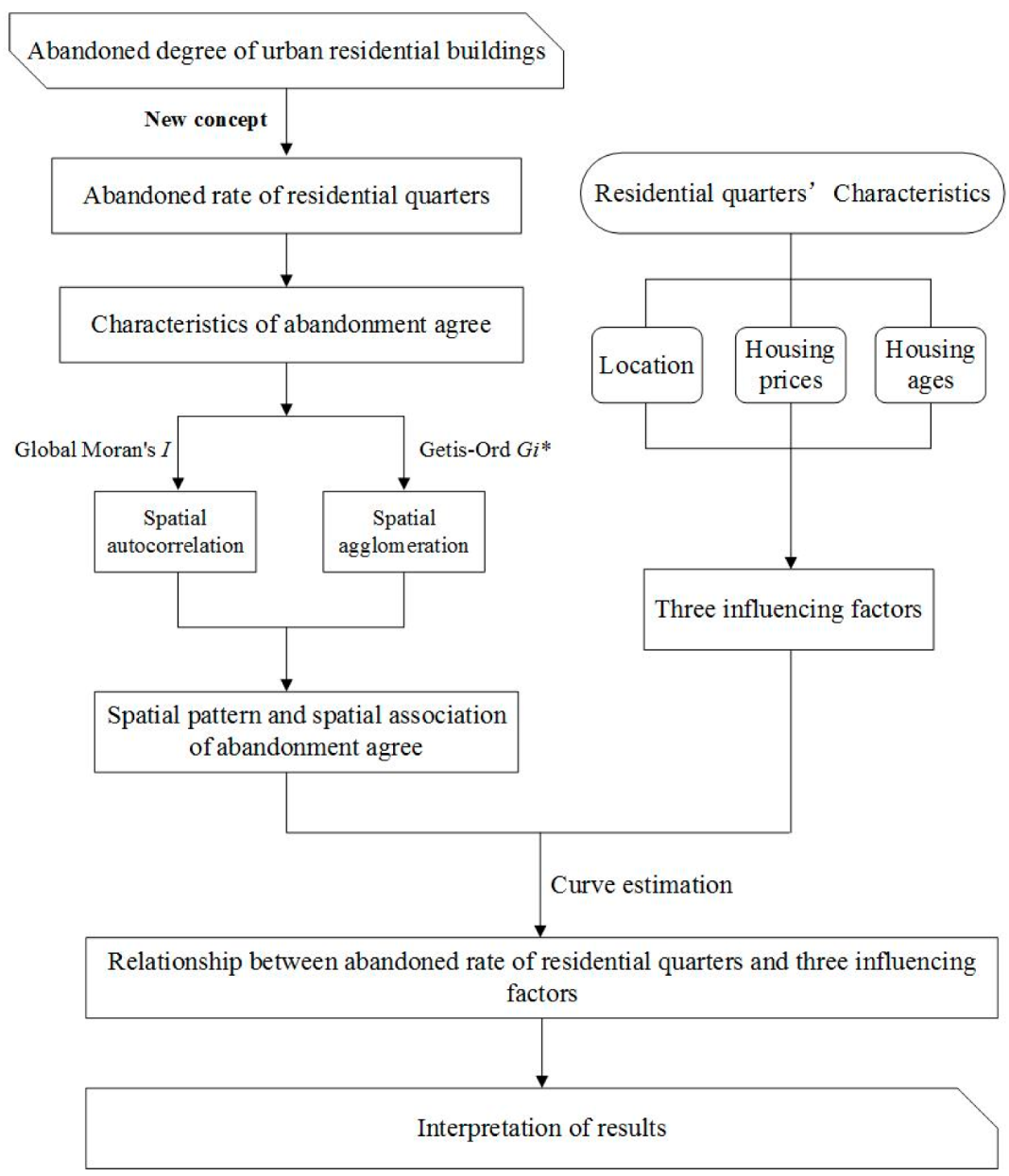

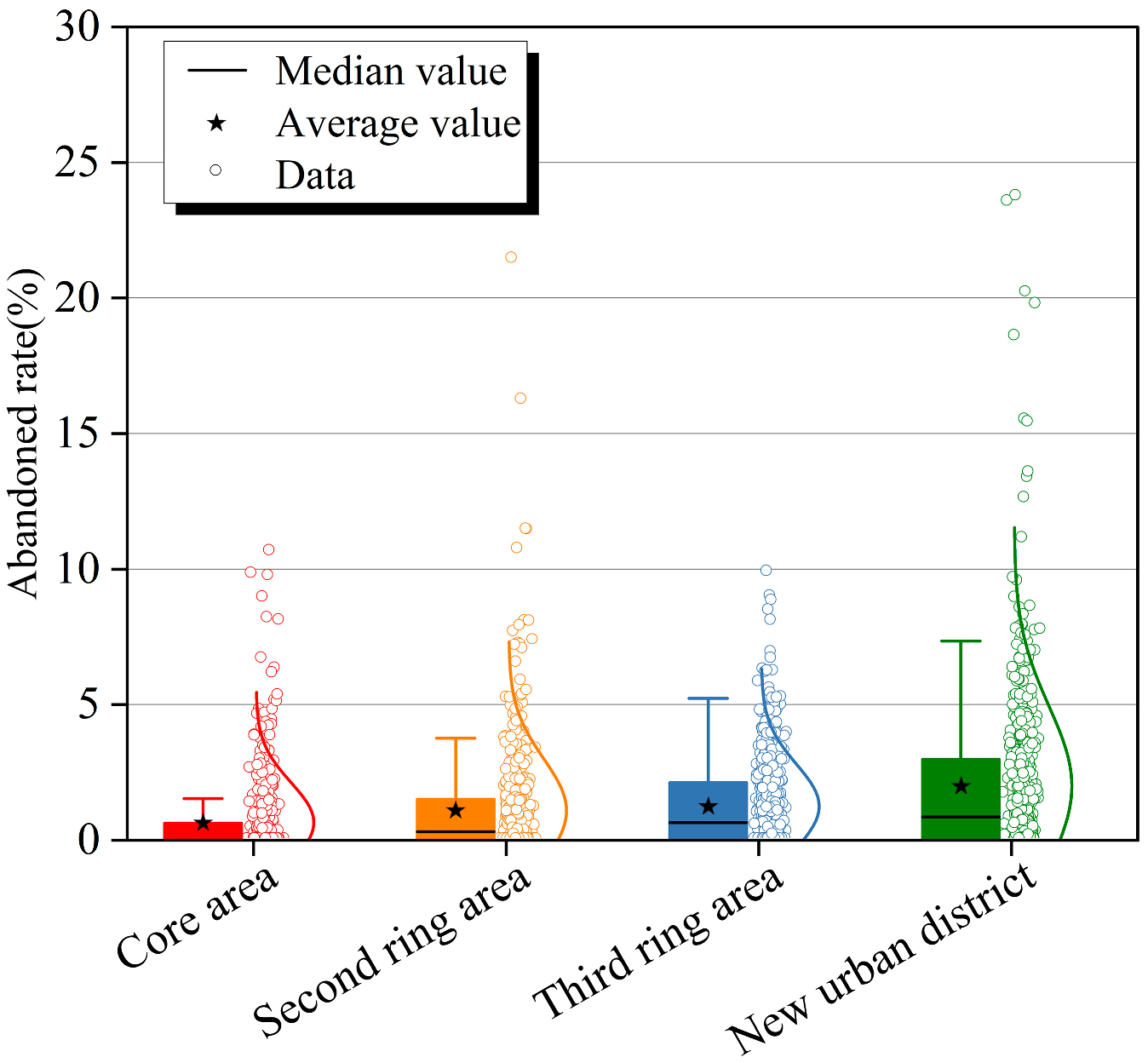
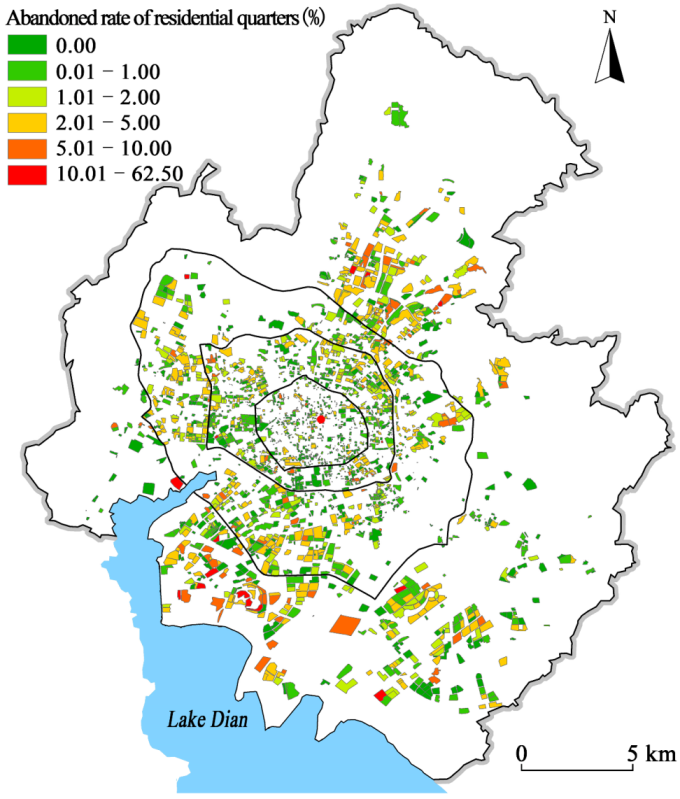
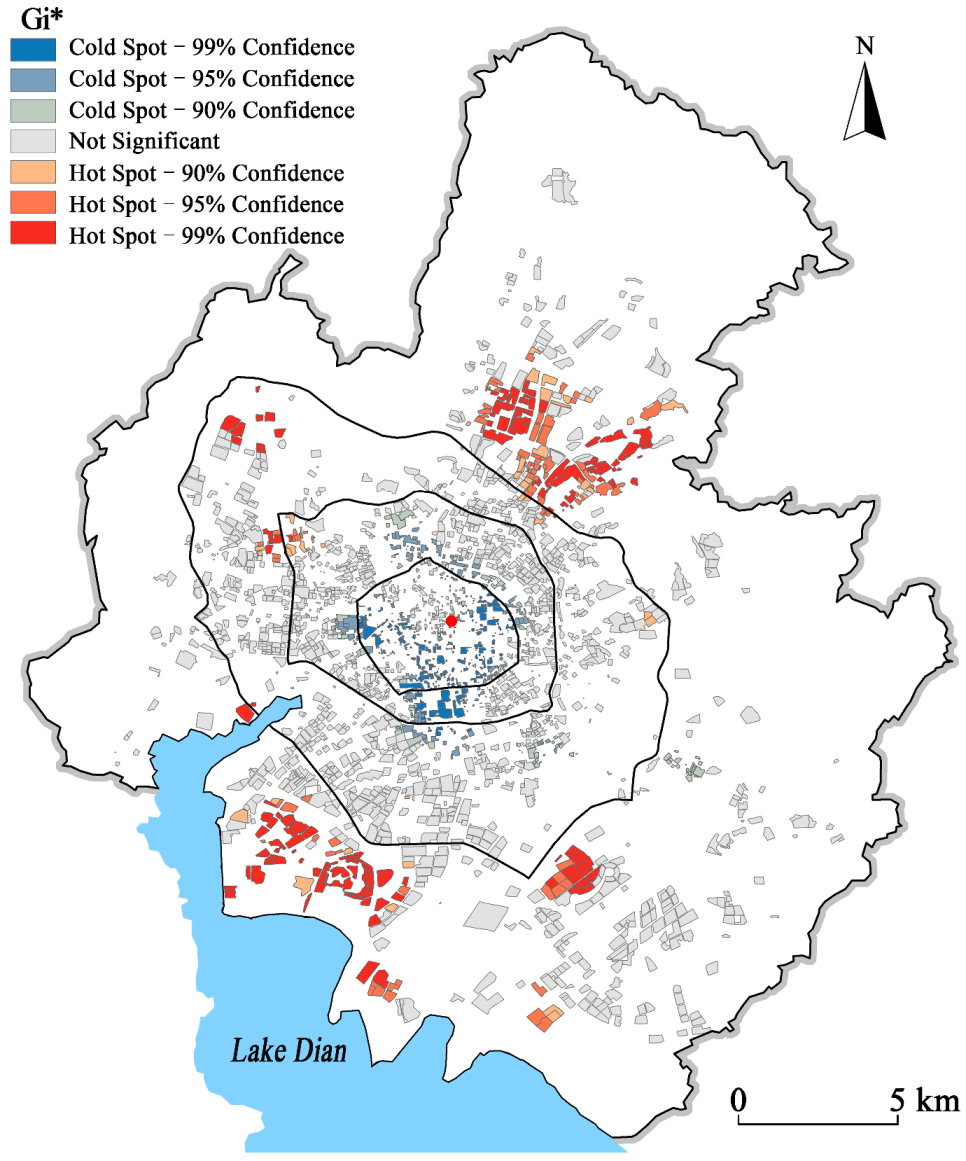
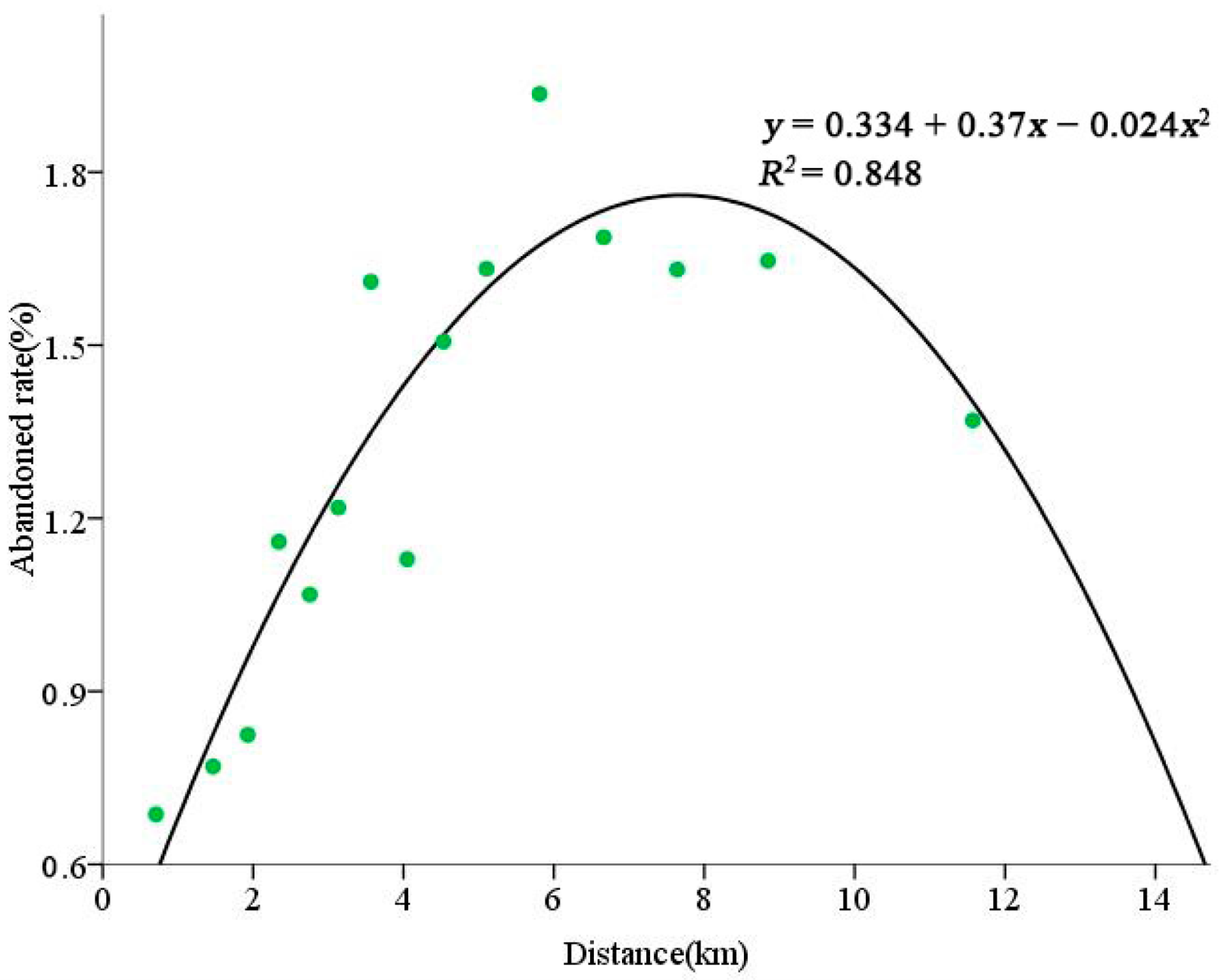
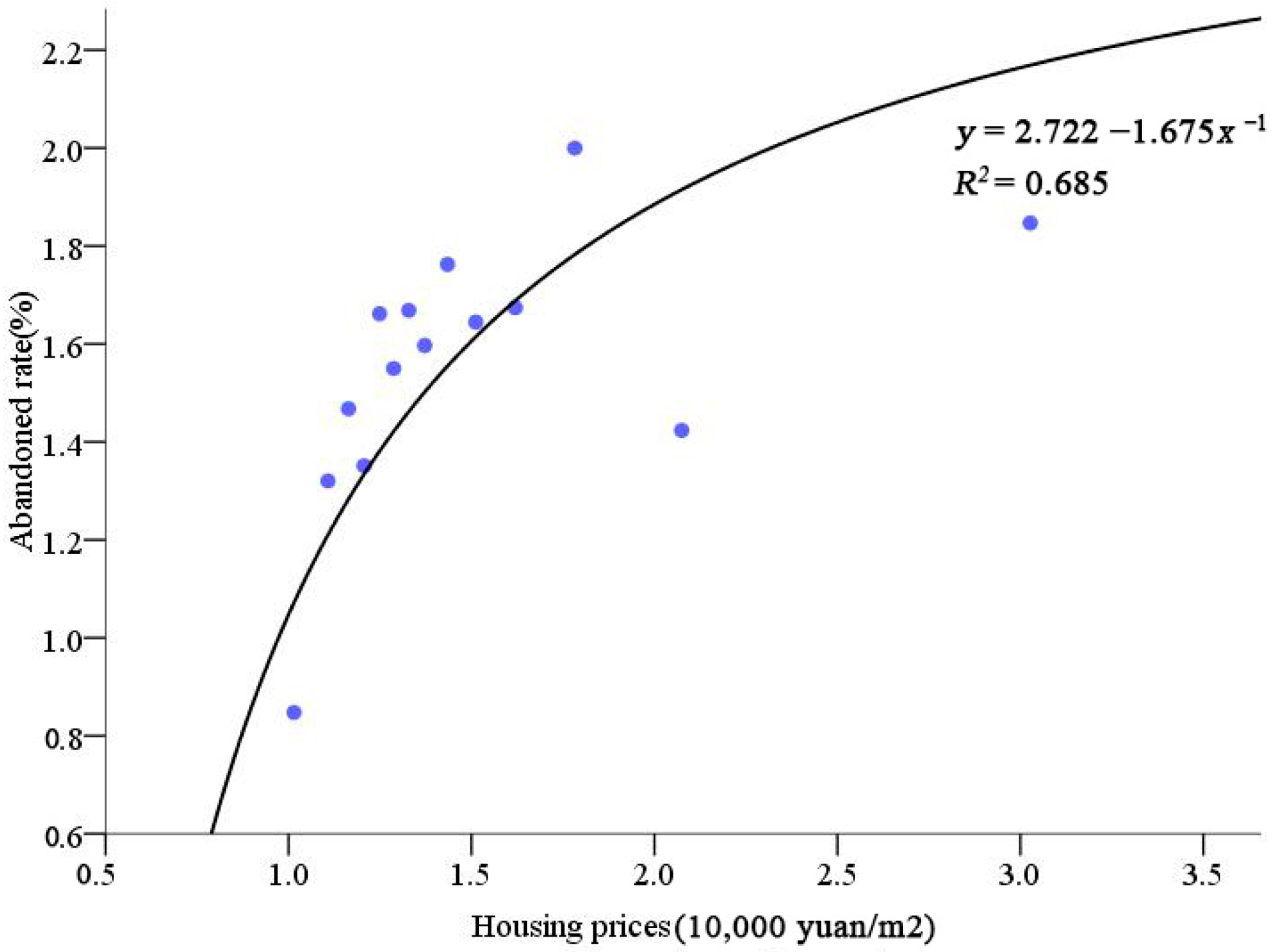
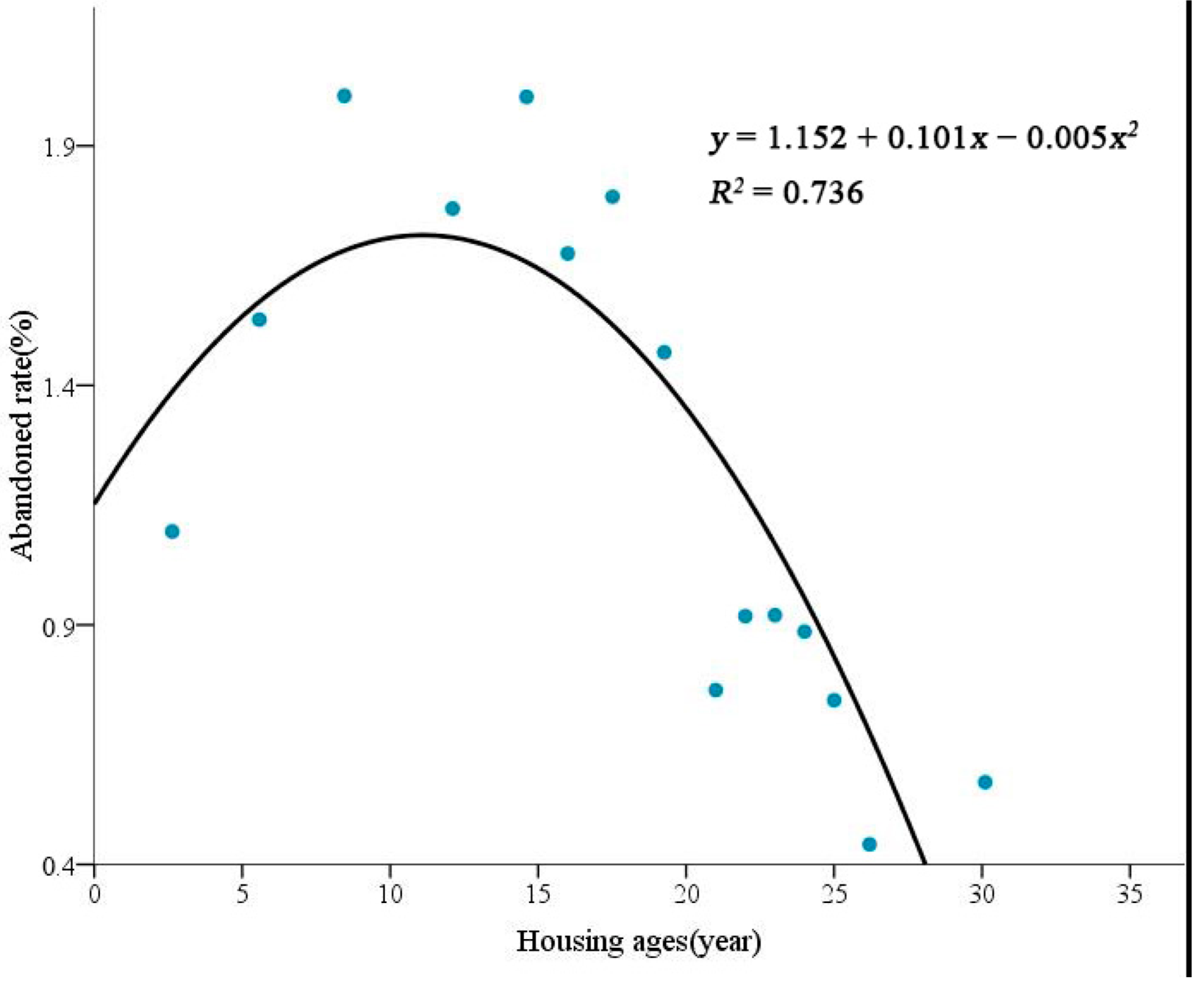
| Core Area | Second Ring Area | Third Ring Area | New Urban District | |
|---|---|---|---|---|
| Houses for sale (sets) | 1023 | 4872 | 8925 | 12653 |
| Total number of houses (sets) | 134,069 | 414,462 | 611,336 | 736,022 |
| abandonment rate (%) | 0.76% | 1.18% | 1.46% | 1.72% |
| Models | Model Summary | Parameter Estimates | |||||
|---|---|---|---|---|---|---|---|
| R2 | F | p | Constant | b1 | b2 | ||
| Distance | Linear function | 0.443 | 10.323 | 0.007 | 0.931 | 0.84 | |
| Logarithmic function | 0.670 | 26.387 | 0.000 | 0.768 | 0.421 | ||
| Quadratic function | 0.848 | 33.474 | 0.000 | 0.334 | 0.370 | −0.024 | |
| Inverse function | 0.586 | 18.383 | 0.001 | 1.632 | −0.867 | ||
| Power function | 0.733 | 35.622 | 0.000 | 0.779 | 0.368 | ||
| Housing prices | Linear function | 0.326 | 6.289 | 0.026 | 0.773 | 0.474 | |
| Logarithmic function | 0.503 | 13.142 | 0.003 | 1.137 | 0.995 | ||
| Quadratic function | 0.679 | 12.706 | 0.001 | −1.389 | 3.064 | −0.677 | |
| Inverse function | 0.685 | 28.331 | 0.000 | 2.722 | −1.675 | ||
| Power function | 0.403 | 8.761 | 0.011 | 0.910 | 1.152 | ||
| Housing ages | Linear function | 0.451 | 10.698 | 0.006 | 2.045 | −0.045 | |
| Logarithmic function | 0.195 | 3.144 | 0.100 | 2.207 | −0.354 | ||
| Quadratic function | 0.736 | 16.719 | 0.000 | 1.152 | 0.101 | −0.005 | |
| Inverse function | 0.031 | 0.410 | 0.533 | 1.150 | 1.039 | ||
| Power function | 0.233 | 3.948 | 0.068 | 2.898 | 3.348 | ||
Disclaimer/Publisher’s Note: The statements, opinions and data contained in all publications are solely those of the individual author(s) and contributor(s) and not of MDPI and/or the editor(s). MDPI and/or the editor(s) disclaim responsibility for any injury to people or property resulting from any ideas, methods, instructions or products referred to in the content. |
© 2022 by the authors. Licensee MDPI, Basel, Switzerland. This article is an open access article distributed under the terms and conditions of the Creative Commons Attribution (CC BY) license (https://creativecommons.org/licenses/by/4.0/).
Share and Cite
Wang, Y.; Yue, X.; Wu, Y.; Zhang, H.; Liu, S. Spatial Characteristics of the Abandonment Degree of Residential Quarters Based on Data of the Housing Sales Ratio—A Case Study of Kunming, China. Buildings 2023, 13, 29. https://doi.org/10.3390/buildings13010029
Wang Y, Yue X, Wu Y, Zhang H, Liu S. Spatial Characteristics of the Abandonment Degree of Residential Quarters Based on Data of the Housing Sales Ratio—A Case Study of Kunming, China. Buildings. 2023; 13(1):29. https://doi.org/10.3390/buildings13010029
Chicago/Turabian StyleWang, Yang, Xiaoli Yue, Yingmei Wu, Hong’ou Zhang, and Sa Liu. 2023. "Spatial Characteristics of the Abandonment Degree of Residential Quarters Based on Data of the Housing Sales Ratio—A Case Study of Kunming, China" Buildings 13, no. 1: 29. https://doi.org/10.3390/buildings13010029
APA StyleWang, Y., Yue, X., Wu, Y., Zhang, H., & Liu, S. (2023). Spatial Characteristics of the Abandonment Degree of Residential Quarters Based on Data of the Housing Sales Ratio—A Case Study of Kunming, China. Buildings, 13(1), 29. https://doi.org/10.3390/buildings13010029







